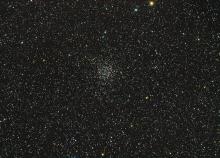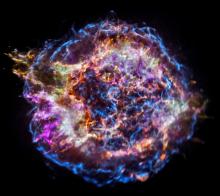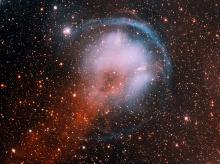Listen to today's episode of StarDate on the web the same day it airs in high-quality streaming audio without any extra ads or announcements. Choose a $8 one-month pass, or listen every day for a year for just $30.
You are here
Rho Cassiopeia
The heaviest stars in the universe eventually blast themselves to bits. But like a kicker getting ready to try a game-winning field goal, they first get in a few practice swings. These smaller explosions blast out shells of hot gas that expand at a million miles an hour.
One example is in Cassiopeia, the queen, whose brightest stars form a letter W. It’s well up in the north-northeast at nightfall.
Rho Cassiopeia is one of the biggest stars in the Milky Way — a yellow hypergiant. If it took the Sun’s place in our own solar system, it would extend past the orbit of Mars.
Rho Cassiopeia is probably a few dozen times heavier than the Sun. And it’s getting near the end of its life. Not long ago, it most likely was a red supergiant, so it was even bigger than it is now. But as a result of changes deep in its core, its outer layers are shrinking and getting hotter. As a result, the star probably will become a smaller and hotter blue supergiant.
These changes also trigger explosions on the surface of Rho Cassiopeia. An eruption in 2000 blasted out the equivalent of about 10,000 Earth masses of material — a half-century after a similar explosion.
More of these eruptions are probably in the star’s future. And eventually, it’ll blow itself apart as a supernova. Its outer layers will blast into space, while its core will be crushed — forming either a super-dense neutron star or an even denser black hole.
Script by Damond Benningfield






